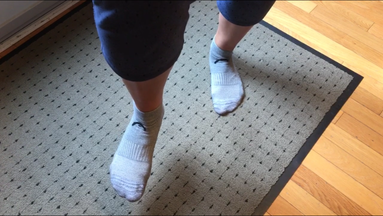 I’ve been carrying a secret around with me for over three months. Partly out of embarrassment — for me and for you, should I decide to share this secret with you. And partly out of a feeling of failure — as in, there must be something wrong with me to let this happen. Are you ready to hear my secret? It has to do with unmentionable parts of my body. Some people, both women and men, make faces, plug their ears, and exclaim absurdities like, “Ew!” when unmentionable topics are finally mentioned. If you’re one of those people, let me be blunt: it’s time to grow the fuck up and have an adult conversation. There are many conditions that impact women’s bodies, including the space south of the belly button, that are not discussed openly. And that’s a problem, because….well, there are many reasons this is a problem. Suffice it to say, I believe we all need to be more open about health issues so we can help ourselves and others.
So, here goes, I’m going to share my secret. For over three months, I’ve been struggling with pelvic organ prolapse — aka POP. In my case, my bladder has prolapsed. That’s right, my bladder decided to pull an Elvis — as in, she wanted to leave the building. Who knew after I turned 50 that I’d join a new group — those women with POP. As in, half of women over the age of 50, and one third of ALL women struggle with POP at some point in their lives. Yet we don't talk about it. I didn't know it was so common, and it's taken me a while to feel comfortable talking about it. It’s not just the diagnosis that can seem like an uncomfortable topic of conversation. The symptoms of POP can also render women shy and withdrawn:
In recent years, there has been an uptick in physiotherapists who are certified to treat pelvic floor conditions like POP. This makes a lot of sense to me: the pelvic floor is a group of muscles that supports the pelvic organs and physiotherapists are trained to help with malfunctioning muscles in every other part of your body. It was the right decision for me to first visit a pelvic floor physiotherapy. I knew exercises would help me sort things out with my body, so a visit to an expert was in order. When I finally visited my doctor’s office, the idea that a specialized physiotherapist could diagnose a prolapse was summarily dismissed. But that's a story for another time. Prolapse is not the only manifestation of pelvic floor dysfunction. Incontinence can also result, along with a host of other conditions. And, in fact, men can also experience pelvic floor dysfunction. In my mind, this is another great reason for us to be discussing what’s happening in our ‘nether regions’ in a non-sexualized fashion. Discussing unmentionables doesn’t begin and end with the pelvic floor. Within the pelvic region, other systems can break down and cause problems. Take endometriosis, for example. It affects 10 to 20 percent of women in their childbearing years (ages 15 to 49). So what exactly is endometriosis? It is “a condition in which tissue similar to the lining inside the uterus (called “the endometrium”), is found outside the uterus, where it induces a chronic inflammatory reaction that may result in scar tissue.” Just like pelvic organ prolapse, the symptoms of endometriosis can be difficult to discuss openly:
Recently, my friend Lara Wellman shared her journey to a diagnosis of endometriosis. Like many girls and women who suffer with undiagnosed endometriosis, she too has been experiencing painful periods since her teenage years. As Lara explains, “I put up with them my whole life. Then, last May, the pain was off the charts the entire day. To the point that I went to the ER to make sure I wasn’t dying. I haven’t had a pain-free day since.” Let that comment sink in: so much pain that she thought she was dying. And Lara has had kids, so she gets vaginal pain from childbirth. Like many “female issues,” the pain we experience during our periods is often dismissed as “just another thing we shouldn’t complain about.” After all, that’s what Midol is for — so the advertisers and medical community tell us. Yet this “normalization” of pain, and the need to not be seen as whining, keep women from talking about their symptoms. As Lara told me, “Doctors aren’t being taught about endometriosis, so they can’t put the pieces together.” Though they acknowledge menstrual pain, they also brush it off: “Oh ya, periods hurt. Try the pill or lots of Advil,” explains Lara. It’s yet another case where women put others' health and wellness ahead of their own. If our child or spouse was in so much pain, we’d be packing them off to the doctor immediately. When it comes to our own bodies, we let things slip when something’s not right “down there.” Look, I know I’m only scratching the surface here when it comes to unmentionable conditions. I haven’t even broached stuff like interstitial cystitis, polycystic ovary syndrome, pelvic inflammatory disease, uterine fibroids, or gynecologic cancers. My point is, we need to start being more open about what’s happening with our bodies. Because someone else is probably also suffering in silence.
1 Comment
 Balancing on one foot Balancing on one foot Later today, I’ll be delivering the first of three workshops on fall prevention. Each one takes place in a different branch of our local library, and cover the east, west, and central parts of Ottawa. I’ve designed an interactive session, where I’ll teach participants the various balance exercises that are featured in my second book, Balance and Your Body: How Exercise Can Help You Avoid a Fall. It seems only fitting that I’m delivering workshops based on my book, since it was a workshop request that precipitated the creation of Balance and Your Body. Here’s another excerpt from my book that addresses static balance.* Is It a Photo or a Video? Balance is a “sweet spot” between our base of support — typically our feet — and our centre of gravity — our weight distribution — while we’re moving or standing still in an upright position. As we move through life, the dynamic aspect is key. We are creatures of movement, and most people want to continue to move. But our aging bodies sometimes have difficulty balancing the key balance components (pun intended). Our balance can suffer as we become less mobile. Imagine a dog walking on a slippery surface. They appear more sure-footed than their human counterparts, who are often slip-sliding along the ice. That's because the dogs have a lower centre of gravity and a wider base of support. Static balance involves maintaining your centre of gravity over your base of support. I like to compare the practice of standing upright to a still photograph. Dynamic balance is when your centre of gravity moves away from your base of support, but you are still in control. That is, your muscles are firing to keep you from falling to the ground. That’s when your balance is more like a video. The exercises in this book target both static and dynamic balance because they’re both important and need to be maintained. Static Balance
As you reduce your base of support, you want to be able to remain standing. There are five foot positions that have you moving from a wide, stable base of support to a narrower, less stable one. They are:
*copyright 2019 Amanda Sterczyk, all rights reserved.
|
Categories
All
Archives
July 2024
AuthorAmanda Sterczyk is an international author, Certified Personal Trainer (ACSM), an Exercise is Medicine Canada (EIMC) Fitness Professional, and a Certified Essentrics® Instructor. |
 RSS Feed
RSS Feed